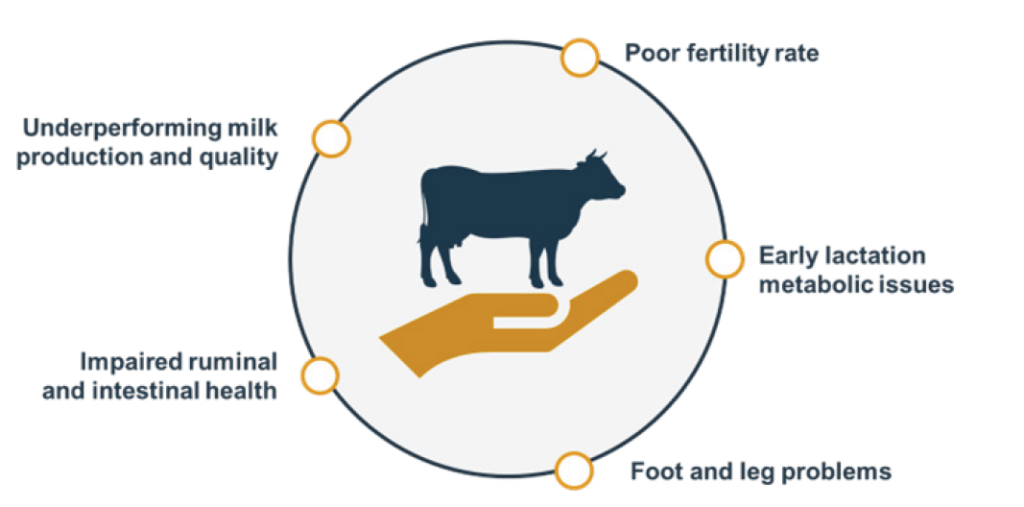Researchers in academics and industry have worked for decades to improve the genetics, health, and performance of farm animals. In dairy farming, this has led to highly efficient production systems with cows able to produce skyrocketing milk yields with fairly limited amounts of resources. Today, having the most efficient dairy cows, in terms of milk production, is part of the race toward the best economic profitability. However, this does not always lead to the most sustainable way of dairy farming. At Agrimprove, we believe longevity should be a driving factor toward sustainable dairy farming.
What is longevity?
Longevity is a complex concept with different parameters used to define it. For many farms, the length of life, the number of lactations, or the herd culling rate are typical guiding parameters used. It is worth noting, these measurements do not take into account the difference between the non-productive and productive life stages of a cow (Figure 1). Therefore, considering life stages, dairy cow longevity can be best defined as an animal having its first calving at an early age followed by a long and productive life with a profitable milk yield (Dallago et al., 2021). This definition takes into account both the period of life where the animal costs money, this is until first calving, and the subsequent period where it brings money.
In the end, farmers will only keep an animal in the herd if it delivers enough revenue, so—when considering both non-productive and productive stages—increasing longevity is a sustainable solution to maximize the profitability of dairy cows and farmer income. Contrary to what most people would expect, generally, the productive life span of dairy cows is decreasing in most high milk-producing countries. This illustrates that high-producing dairy cows are often pushed to their maximum capabilities due to problems arising during calf rearing, first parity, and (especially) in multiparous animals. Once health issues appear, cows have to leave the herd early, which heavily impacts whole-life profitability.

Culling decisions impact profitability
To optimize the productive life span, farmers have to keep their cows longer in the herd. High-producing dairy farms often have a replacement rate of about 30%, which means that cows reach an average age of 4 to 5 years and few cows reach more than two calvings. Dairy cows typically reach their full milking potential at the third lactation. This means profitability can be heavily increased by postponing the culling age.
It is well known by farmers that the onset of lactation increases the number of cows with metabolic problems which could lead to reduced fertility, especially from second parity. This period determines if the farmer will remove animals from the herd to keep up the profitability of the farm. During the Sustainable Dairy Farming webinar by Dairy Global in June 2022, the audience was asked, ‘What is their main reason to cull a dairy cow from the herd?’. Almost 50% of viewers indicated that cows are removed because they are suffering from health issues. From this information, avoiding health problems by improving cow management and nutritional interventions can help to delay the culling decisions that heavily impact the longevity of cows and farm profitability.
Recognizing problems that affect longevity
The reasons to remove animals from the herd can be classified into five categories (Figure 2). First, animals are often culled because milk production is less than expected. Variation in feed efficiency between animals is the main driver of underperforming milk production. Genetic selection can improve individual animal efficiency but only in the next generation. To support the current generation, all energy and protein losses from (subacute) infections should be reduced as much as possible to prevent the occurrence of metabolic diseases—such as fatty liver or ketosis. This helps to improve the immune status around calving and avoid inefficient energy losses. Also, a healthy microbiome and gastrointestinal tract reduces the chance of an early lactation negative energy balance occurring, giving the cows a head start for optimal lactation.

As it is directly correlated with milk production and the general well-being of the animals, foot and leg problems are another reason for culling. Finally, a poor fertility rate is considered an important reason to cull animals. When too many insemination attempts are required, the cow’s profitability is heavily under pressure. Unfortunately, with increasing milk production over the years, fertility has steadily decreased (Butler, 2003). More and more scientific literature indicates this is associated with the occurrence of a negative energy balance after calving.
Finding solutions to improve herd longevity
At Agrimprove, we work every day to find solutions that help farmers improve the profitability of their farm. We find that keeping dairy cows in the herd for a longer period of time can positively enhance profitability and help support the sustainable use of animals for food production. As previously mentioned, the time around calving is a period with a lot of pressure on health and performance. Focusing on transitioning a cow smoothly from calving towards lactation can delay culling. Medium-chain fatty acids, like those in Aromabiotic® Cattle, have proved to support immunity around the challenging period of transition. Another way to handle this challenge is by adding natural anti-oxidants found in Vitanox to support gut health. These antioxidants can also help reduce costs by lowering the high cost of other antioxidants, such as vitamin E. It is also important to take the risk of mycotoxins and endotoxins seriously as toxins have a negative impact on health and performance in high-producing dairy cows. Therefore, it is advised to apply a maintenance dosage of a scientifically proven toxin binder like Vitafix® Spectrum.
Functional feed ingredient solutions are being further developed to ensure a reduction in involuntary culling. This is so longevity can be achieved and dairy cows can reach their maximum potential to support both sustainability and profitability. With Agrimprove we aim to support farmers by helping them produce food in a profitable and sustainable way.
